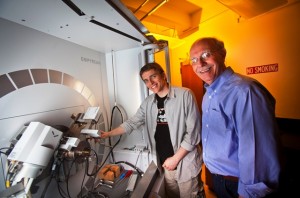High-tech X-ray equipment funded by a $265,000 National Science Foundation grant is opening up valuable opportunities in classroom instruction and research.

Derek Morris ’13 and Professor Guy Hovis with the Geology Department’s PANalytical Empyrean x-ray diffractometer in Van Wickle Hall
Housed in the Geology and Environmental Geosciences Department, the new X-ray system enables professors and students to make high-temperature measurements to study thermal expansion in minerals as well as to identify naturally occurring and synthetic minerals, according to Guy Hovis, Markle Professor of Geology and Environmental Geosciences, who applied for the grant. Geologists seek to discover the principles involved in how minerals respond to increasing temperature and how the atomic structures of minerals mechanistically expand, he says.
“In the past I would take students to Cambridge University to make the measurements, but now we’ll be able to make the measurements here at Lafayette,” says Hovis. “Past work has been published as student-coauthored papers in highly respected peer-reviewed journals.”
There are many additional measurements the X-ray system can take that would be of interest to other departments at Lafayette, including those in engineering, the natural sciences, and some non-technical programs.
According to Hovis, areas in which it could be used include residual stress (relating to the strength of materials), Rietveld analysis (detailed information about crystal structures), nanomaterials, computed tomography (size, shape, inner morphology, and pore distributions of certain small samples), thin films, semi-conductors, micro-diffraction (e.g. to study paint flakes from ancient masterpieces), and texture analysis of metals and ceramics.
The equipment enables Hovis’ calorimetry lab to characterize the materials being studied. His Geology 200 class, Earth and Planetary Materials, uses the unit to acquire information on the lattice dimensions of crystalline compounds and to identify minerals. Two students this summer will use it to study the thermal expansion of additional mineral systems through Lafayette’s EXCEL Scholars undergraduate research program.
Geology major Derek Morris ’13 (Lewiston, Maine) used the equipment for an independent study project on the thermal expansion of a group of minerals called pyroxenes.
“The unit sends out X-rays to a sample and bounces its atomic structure back,” he explains. “The unit is then used to observe how this atomic structure changes with increasing heat. This knowledge is useful because it helps geologists understand how minerals behave deep down in the earth’s crust where it is really hot.”
According to Morris, using the machine was the major benefit of his two-semester research project.
“It took the better part of a semester to just learn the basics of being able to use this machine and the associated programs,” he says. “So just the ability to use the thing is a marketable skill in itself. Being able to apply to grad schools already having this experience and training was a huge help.”

1 Comment
Go Derek! You’re awesome!! 🙂
Comments are closed.